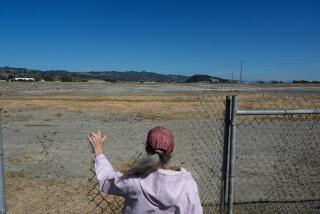Fears of N-Waste Tank Blast Prompt Tests : Radioactivity: Scientists plan to take samples from a vast tank at Hanford, Wash., that is experiencing a buildup of flammable hydrogen gas.
- Share via
WASHINGTON — Concerned over the potential for chemical explosions in tanks of liquid nuclear waste, scientists have laid plans to take crucial samples from a million-gallon container of radioactive brew buried at the Hanford, Wash., nuclear weapons complex.
The operation comes in the wake of new warnings that the buildup of gas in steel waste tanks could cause explosions powerful enough to rupture them and cause disastrous releases of high-level radioactivity.
“We are not saying that we know there is definitely a high risk, but there is potentially a high risk,” said John Ahearne in testimony before the Senate Governmental Affairs Committee Tuesday. Ahearne is chairman of the Energy Department’s Advisory Committee on Nuclear Facility Safety.
Sen. John Glenn (D-Ohio), the committee chairman, said that some Hanford tanks could have an explosive potential of 36 tons of TNT.
Ahearne and other independent experts told the committee that urgent priority should be given to fully understanding chemical reactions taking place in the waste tanks as a first step toward solving one of the country’s most delicate refuse problems.
Toward that end, Westinghouse Hanford Co., which maintains the Department of Energy’s huge radioactive tank farm, has assembled a team of experts to sample the contents of the most troublesome tank, the SY-101.
The double-walled tank periodically “burps” as hydrogen gas builds up in the waste material and breaks through a solid crust that forms on the surface of the waste. It is then released through filtered vents.
While numerous investigations over the years have concluded that the risk of tank explosions is low, Ahearne’s committee told Energy Secretary James D. Watkins last week that the Hanford situation must be regarded as serious.
The Ahearne panel report was followed Tuesday with one from the Energy Department’s own Office of Nuclear Safety, which said that operating contractors at Hanford have been aware of the problem of gas generation in SY-101 for 13 years but have done nothing to alleviate the danger of combustion.
The report said that DOE officials, as well as those from Westinghouse, Rockwell Hanford Operations and Atlantic Richfield Hanford Co., “failed to exercise appropriate safety oversight of tank operations. . . .”
The deficiencies were attributed to many factors, including “a degree of complacency, lack of discipline in operations, poor management, primacy of production over safety . . . (and) inadequate training and staffing,” said Steven M. Blush, director of the Nuclear Safety Office.
The Hanford tank farm has 177 tanks holding some 200,000 cubic meters of waste generated in plutonium production operations going back to the early 1940s. Sixty-six of the tanks are known or suspected of leaking, and 23 are a source of concern over gas generation.
Another vast quantity of similar waste is stored at another tank farm at the Energy Department’s facility at Savannah River, S.C.
The problem of the Hanford tank farm is far more serious because organic materials were added to its tanks, and the materials accelerated the production of hydrogen gas in the tanks.
Because the buried tanks have sat for decades, Ahearne told the Senate panel, there is great uncertainty about the chemical reactions taking place, and in many cases, about the kinds of material put into them in the first place.
More to Read
Sign up for Essential California
The most important California stories and recommendations in your inbox every morning.
You may occasionally receive promotional content from the Los Angeles Times.










